Project Risk, Finance, and Monitoring: An Individual Report - MBA643
VerifiedAdded on 2023/06/11
|13
|3942
|148
Report
AI Summary
This report provides an overview of project risk, finance, and monitoring, starting with an executive summary and recommendations. It discusses project selection using investment appraisal techniques like NPV and IRR, emphasizing the importance of cost management through methods like Project Cost Management (PCM). The report explores various funding sources, including retained earnings, venture capitalists, bank borrowings, government grants, and equity offerings. It also addresses project implementation, winding up, and resource considerations. Part B analyzes Myer Holdings' equity capital and includes a capital budgeting analysis with revenue, costs, depreciation, and EBIT projections for five years. Desklib offers similar solved assignments and past papers for students.

PROJECT RISK, FINANCE AND MONITORING 1
Project Risk, Finance, and Monitoring
Student’s Name
Institutional Affiliation
Project Risk, Finance, and Monitoring
Student’s Name
Institutional Affiliation
Paraphrase This Document
Need a fresh take? Get an instant paraphrase of this document with our AI Paraphraser
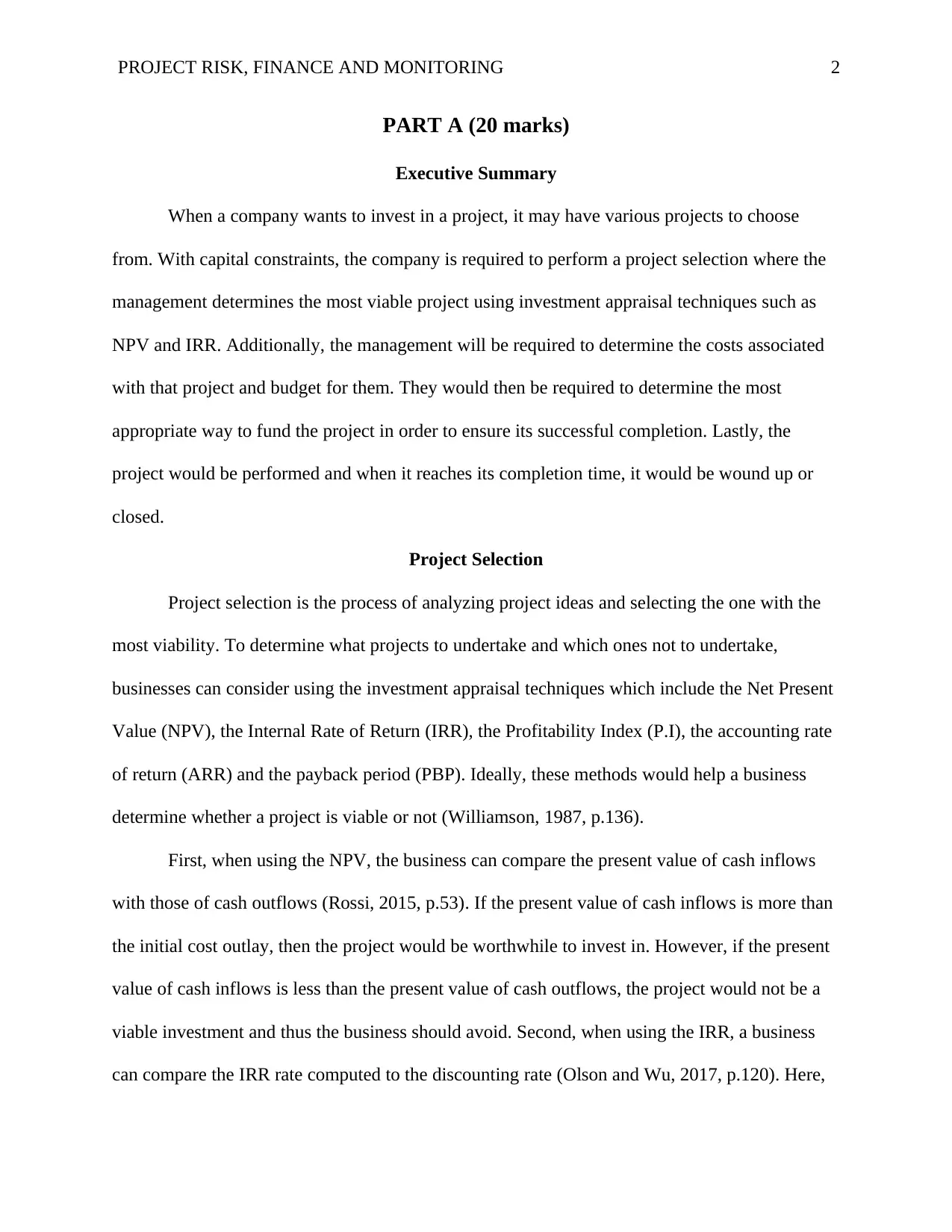
PROJECT RISK, FINANCE AND MONITORING 2
PART A (20 marks)
Executive Summary
When a company wants to invest in a project, it may have various projects to choose
from. With capital constraints, the company is required to perform a project selection where the
management determines the most viable project using investment appraisal techniques such as
NPV and IRR. Additionally, the management will be required to determine the costs associated
with that project and budget for them. They would then be required to determine the most
appropriate way to fund the project in order to ensure its successful completion. Lastly, the
project would be performed and when it reaches its completion time, it would be wound up or
closed.
Project Selection
Project selection is the process of analyzing project ideas and selecting the one with the
most viability. To determine what projects to undertake and which ones not to undertake,
businesses can consider using the investment appraisal techniques which include the Net Present
Value (NPV), the Internal Rate of Return (IRR), the Profitability Index (P.I), the accounting rate
of return (ARR) and the payback period (PBP). Ideally, these methods would help a business
determine whether a project is viable or not (Williamson, 1987, p.136).
First, when using the NPV, the business can compare the present value of cash inflows
with those of cash outflows (Rossi, 2015, p.53). If the present value of cash inflows is more than
the initial cost outlay, then the project would be worthwhile to invest in. However, if the present
value of cash inflows is less than the present value of cash outflows, the project would not be a
viable investment and thus the business should avoid. Second, when using the IRR, a business
can compare the IRR rate computed to the discounting rate (Olson and Wu, 2017, p.120). Here,
PART A (20 marks)
Executive Summary
When a company wants to invest in a project, it may have various projects to choose
from. With capital constraints, the company is required to perform a project selection where the
management determines the most viable project using investment appraisal techniques such as
NPV and IRR. Additionally, the management will be required to determine the costs associated
with that project and budget for them. They would then be required to determine the most
appropriate way to fund the project in order to ensure its successful completion. Lastly, the
project would be performed and when it reaches its completion time, it would be wound up or
closed.
Project Selection
Project selection is the process of analyzing project ideas and selecting the one with the
most viability. To determine what projects to undertake and which ones not to undertake,
businesses can consider using the investment appraisal techniques which include the Net Present
Value (NPV), the Internal Rate of Return (IRR), the Profitability Index (P.I), the accounting rate
of return (ARR) and the payback period (PBP). Ideally, these methods would help a business
determine whether a project is viable or not (Williamson, 1987, p.136).
First, when using the NPV, the business can compare the present value of cash inflows
with those of cash outflows (Rossi, 2015, p.53). If the present value of cash inflows is more than
the initial cost outlay, then the project would be worthwhile to invest in. However, if the present
value of cash inflows is less than the present value of cash outflows, the project would not be a
viable investment and thus the business should avoid. Second, when using the IRR, a business
can compare the IRR rate computed to the discounting rate (Olson and Wu, 2017, p.120). Here,
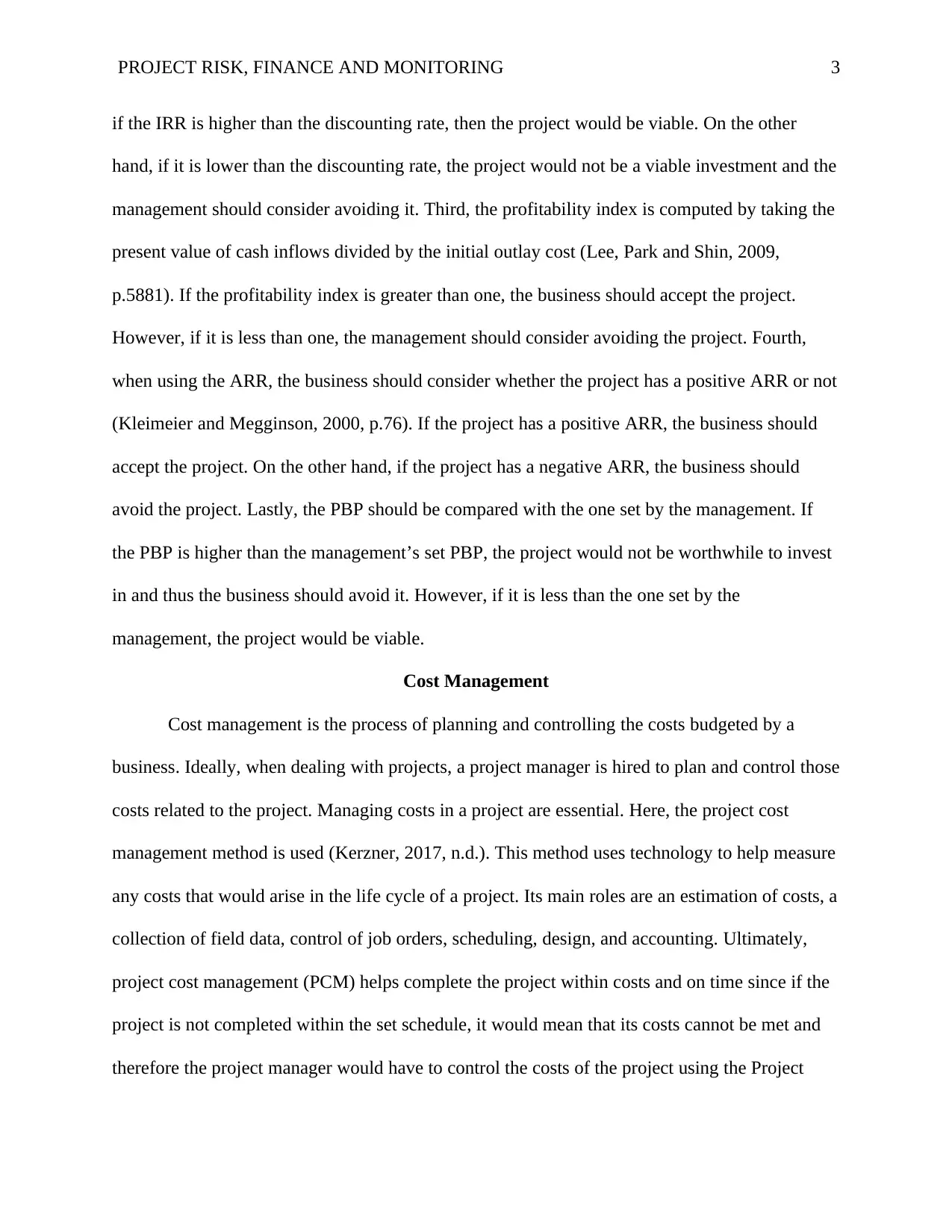
PROJECT RISK, FINANCE AND MONITORING 3
if the IRR is higher than the discounting rate, then the project would be viable. On the other
hand, if it is lower than the discounting rate, the project would not be a viable investment and the
management should consider avoiding it. Third, the profitability index is computed by taking the
present value of cash inflows divided by the initial outlay cost (Lee, Park and Shin, 2009,
p.5881). If the profitability index is greater than one, the business should accept the project.
However, if it is less than one, the management should consider avoiding the project. Fourth,
when using the ARR, the business should consider whether the project has a positive ARR or not
(Kleimeier and Megginson, 2000, p.76). If the project has a positive ARR, the business should
accept the project. On the other hand, if the project has a negative ARR, the business should
avoid the project. Lastly, the PBP should be compared with the one set by the management. If
the PBP is higher than the management’s set PBP, the project would not be worthwhile to invest
in and thus the business should avoid it. However, if it is less than the one set by the
management, the project would be viable.
Cost Management
Cost management is the process of planning and controlling the costs budgeted by a
business. Ideally, when dealing with projects, a project manager is hired to plan and control those
costs related to the project. Managing costs in a project are essential. Here, the project cost
management method is used (Kerzner, 2017, n.d.). This method uses technology to help measure
any costs that would arise in the life cycle of a project. Its main roles are an estimation of costs, a
collection of field data, control of job orders, scheduling, design, and accounting. Ultimately,
project cost management (PCM) helps complete the project within costs and on time since if the
project is not completed within the set schedule, it would mean that its costs cannot be met and
therefore the project manager would have to control the costs of the project using the Project
if the IRR is higher than the discounting rate, then the project would be viable. On the other
hand, if it is lower than the discounting rate, the project would not be a viable investment and the
management should consider avoiding it. Third, the profitability index is computed by taking the
present value of cash inflows divided by the initial outlay cost (Lee, Park and Shin, 2009,
p.5881). If the profitability index is greater than one, the business should accept the project.
However, if it is less than one, the management should consider avoiding the project. Fourth,
when using the ARR, the business should consider whether the project has a positive ARR or not
(Kleimeier and Megginson, 2000, p.76). If the project has a positive ARR, the business should
accept the project. On the other hand, if the project has a negative ARR, the business should
avoid the project. Lastly, the PBP should be compared with the one set by the management. If
the PBP is higher than the management’s set PBP, the project would not be worthwhile to invest
in and thus the business should avoid it. However, if it is less than the one set by the
management, the project would be viable.
Cost Management
Cost management is the process of planning and controlling the costs budgeted by a
business. Ideally, when dealing with projects, a project manager is hired to plan and control those
costs related to the project. Managing costs in a project are essential. Here, the project cost
management method is used (Kerzner, 2017, n.d.). This method uses technology to help measure
any costs that would arise in the life cycle of a project. Its main roles are an estimation of costs, a
collection of field data, control of job orders, scheduling, design, and accounting. Ultimately,
project cost management (PCM) helps complete the project within costs and on time since if the
project is not completed within the set schedule, it would mean that its costs cannot be met and
therefore the project manager would have to control the costs of the project using the Project
⊘ This is a preview!⊘
Do you want full access?
Subscribe today to unlock all pages.

Trusted by 1+ million students worldwide

PROJECT RISK, FINANCE AND MONITORING 4
Cost Management (PCM) method, thus enabling the project to be completed within the set
budget (Diamond, 1984, p.394). The Project Cost Management (PCM) is important since it helps
the company to be able to complete the project within the set budget, thus preventing issues such
as the crushing of the project and injecting of additional resources that had not been planned for
into the business from arising. To manage project costs effectively, four strategies or approaches
can be used, that is, proper planning of the costs to be incurred, estimation of the costs that
would be incurred by the business in relation to the project, determining of a proper budget for
the project (the revenues, incomes and expenditure associated with the business) and proper
control of project costs (Demirag, 2017, p.78). By doing this, the business would ensure that they
are able to complete the project within the set budget.
Funding
When a business wants to invest in a project, they can source for funding from several
sources which would assist them to fund the proposed new projects. These sources of financing
include savings, venture, and angel capitalists, borrowing from banks, government grants and
subsidies, equity shareholders or going public (initial public offering). First, a business can fund
a new project from their savings or retained earnings (Delmon, 2009, n.d.). These are the
amounts of profits that are held by a company instead of being paid out as dividends. The
advantage of this is that the business would be able to get their desired funds without outsourcing
from other sources such as venture capitalists, angel capitalist, and equity shareholders. Besides,
retained earnings when used to fund a project does not add up to the debt profile of a company
and therefore it can be used as a powerful strategy. However, using the retained earnings
available in the business may lead to the depletion of the internally available resources, thus the
business may lack funds for its core operations.
Cost Management (PCM) method, thus enabling the project to be completed within the set
budget (Diamond, 1984, p.394). The Project Cost Management (PCM) is important since it helps
the company to be able to complete the project within the set budget, thus preventing issues such
as the crushing of the project and injecting of additional resources that had not been planned for
into the business from arising. To manage project costs effectively, four strategies or approaches
can be used, that is, proper planning of the costs to be incurred, estimation of the costs that
would be incurred by the business in relation to the project, determining of a proper budget for
the project (the revenues, incomes and expenditure associated with the business) and proper
control of project costs (Demirag, 2017, p.78). By doing this, the business would ensure that they
are able to complete the project within the set budget.
Funding
When a business wants to invest in a project, they can source for funding from several
sources which would assist them to fund the proposed new projects. These sources of financing
include savings, venture, and angel capitalists, borrowing from banks, government grants and
subsidies, equity shareholders or going public (initial public offering). First, a business can fund
a new project from their savings or retained earnings (Delmon, 2009, n.d.). These are the
amounts of profits that are held by a company instead of being paid out as dividends. The
advantage of this is that the business would be able to get their desired funds without outsourcing
from other sources such as venture capitalists, angel capitalist, and equity shareholders. Besides,
retained earnings when used to fund a project does not add up to the debt profile of a company
and therefore it can be used as a powerful strategy. However, using the retained earnings
available in the business may lead to the depletion of the internally available resources, thus the
business may lack funds for its core operations.
Paraphrase This Document
Need a fresh take? Get an instant paraphrase of this document with our AI Paraphraser
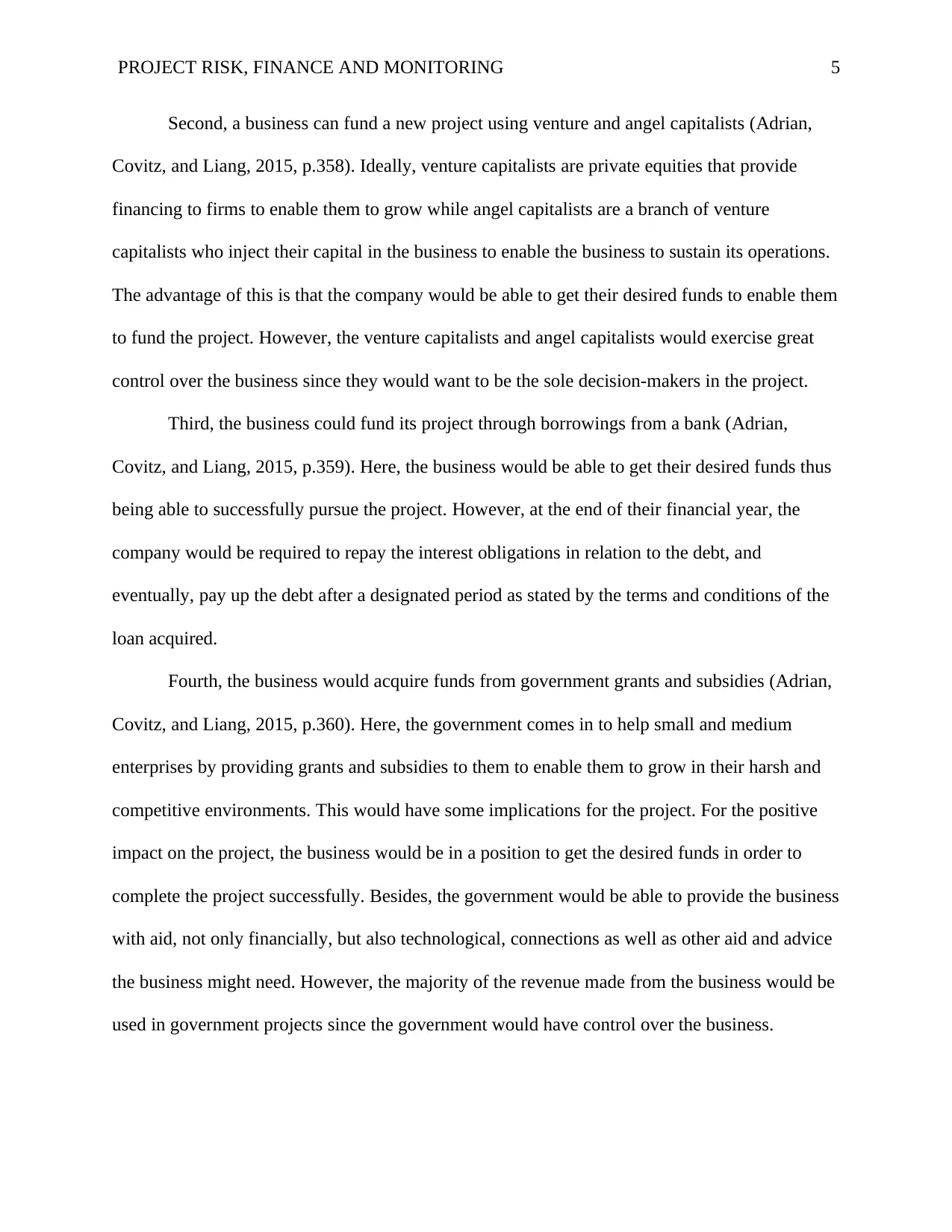
PROJECT RISK, FINANCE AND MONITORING 5
Second, a business can fund a new project using venture and angel capitalists (Adrian,
Covitz, and Liang, 2015, p.358). Ideally, venture capitalists are private equities that provide
financing to firms to enable them to grow while angel capitalists are a branch of venture
capitalists who inject their capital in the business to enable the business to sustain its operations.
The advantage of this is that the company would be able to get their desired funds to enable them
to fund the project. However, the venture capitalists and angel capitalists would exercise great
control over the business since they would want to be the sole decision-makers in the project.
Third, the business could fund its project through borrowings from a bank (Adrian,
Covitz, and Liang, 2015, p.359). Here, the business would be able to get their desired funds thus
being able to successfully pursue the project. However, at the end of their financial year, the
company would be required to repay the interest obligations in relation to the debt, and
eventually, pay up the debt after a designated period as stated by the terms and conditions of the
loan acquired.
Fourth, the business would acquire funds from government grants and subsidies (Adrian,
Covitz, and Liang, 2015, p.360). Here, the government comes in to help small and medium
enterprises by providing grants and subsidies to them to enable them to grow in their harsh and
competitive environments. This would have some implications for the project. For the positive
impact on the project, the business would be in a position to get the desired funds in order to
complete the project successfully. Besides, the government would be able to provide the business
with aid, not only financially, but also technological, connections as well as other aid and advice
the business might need. However, the majority of the revenue made from the business would be
used in government projects since the government would have control over the business.
Second, a business can fund a new project using venture and angel capitalists (Adrian,
Covitz, and Liang, 2015, p.358). Ideally, venture capitalists are private equities that provide
financing to firms to enable them to grow while angel capitalists are a branch of venture
capitalists who inject their capital in the business to enable the business to sustain its operations.
The advantage of this is that the company would be able to get their desired funds to enable them
to fund the project. However, the venture capitalists and angel capitalists would exercise great
control over the business since they would want to be the sole decision-makers in the project.
Third, the business could fund its project through borrowings from a bank (Adrian,
Covitz, and Liang, 2015, p.359). Here, the business would be able to get their desired funds thus
being able to successfully pursue the project. However, at the end of their financial year, the
company would be required to repay the interest obligations in relation to the debt, and
eventually, pay up the debt after a designated period as stated by the terms and conditions of the
loan acquired.
Fourth, the business would acquire funds from government grants and subsidies (Adrian,
Covitz, and Liang, 2015, p.360). Here, the government comes in to help small and medium
enterprises by providing grants and subsidies to them to enable them to grow in their harsh and
competitive environments. This would have some implications for the project. For the positive
impact on the project, the business would be in a position to get the desired funds in order to
complete the project successfully. Besides, the government would be able to provide the business
with aid, not only financially, but also technological, connections as well as other aid and advice
the business might need. However, the majority of the revenue made from the business would be
used in government projects since the government would have control over the business.
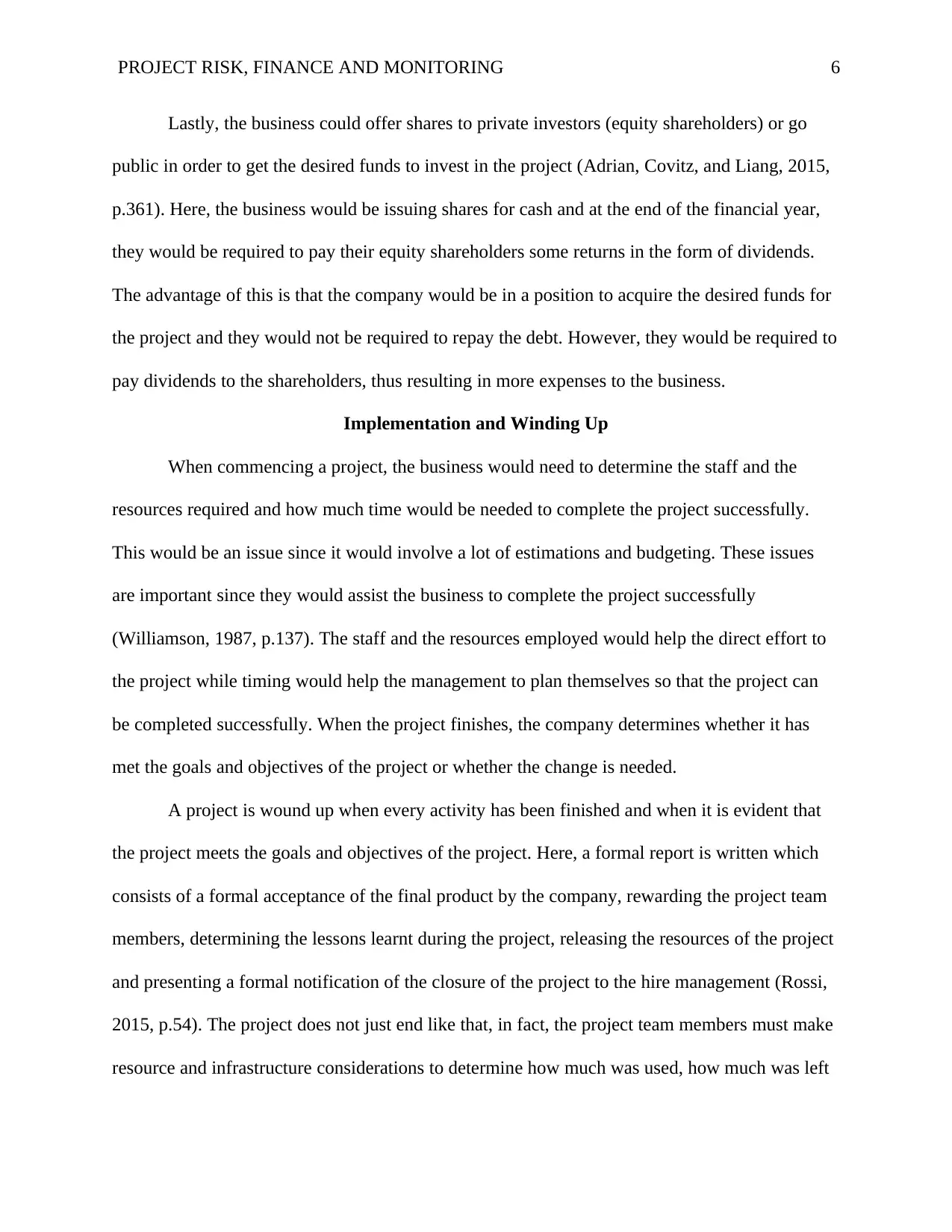
PROJECT RISK, FINANCE AND MONITORING 6
Lastly, the business could offer shares to private investors (equity shareholders) or go
public in order to get the desired funds to invest in the project (Adrian, Covitz, and Liang, 2015,
p.361). Here, the business would be issuing shares for cash and at the end of the financial year,
they would be required to pay their equity shareholders some returns in the form of dividends.
The advantage of this is that the company would be in a position to acquire the desired funds for
the project and they would not be required to repay the debt. However, they would be required to
pay dividends to the shareholders, thus resulting in more expenses to the business.
Implementation and Winding Up
When commencing a project, the business would need to determine the staff and the
resources required and how much time would be needed to complete the project successfully.
This would be an issue since it would involve a lot of estimations and budgeting. These issues
are important since they would assist the business to complete the project successfully
(Williamson, 1987, p.137). The staff and the resources employed would help the direct effort to
the project while timing would help the management to plan themselves so that the project can
be completed successfully. When the project finishes, the company determines whether it has
met the goals and objectives of the project or whether the change is needed.
A project is wound up when every activity has been finished and when it is evident that
the project meets the goals and objectives of the project. Here, a formal report is written which
consists of a formal acceptance of the final product by the company, rewarding the project team
members, determining the lessons learnt during the project, releasing the resources of the project
and presenting a formal notification of the closure of the project to the hire management (Rossi,
2015, p.54). The project does not just end like that, in fact, the project team members must make
resource and infrastructure considerations to determine how much was used, how much was left
Lastly, the business could offer shares to private investors (equity shareholders) or go
public in order to get the desired funds to invest in the project (Adrian, Covitz, and Liang, 2015,
p.361). Here, the business would be issuing shares for cash and at the end of the financial year,
they would be required to pay their equity shareholders some returns in the form of dividends.
The advantage of this is that the company would be in a position to acquire the desired funds for
the project and they would not be required to repay the debt. However, they would be required to
pay dividends to the shareholders, thus resulting in more expenses to the business.
Implementation and Winding Up
When commencing a project, the business would need to determine the staff and the
resources required and how much time would be needed to complete the project successfully.
This would be an issue since it would involve a lot of estimations and budgeting. These issues
are important since they would assist the business to complete the project successfully
(Williamson, 1987, p.137). The staff and the resources employed would help the direct effort to
the project while timing would help the management to plan themselves so that the project can
be completed successfully. When the project finishes, the company determines whether it has
met the goals and objectives of the project or whether the change is needed.
A project is wound up when every activity has been finished and when it is evident that
the project meets the goals and objectives of the project. Here, a formal report is written which
consists of a formal acceptance of the final product by the company, rewarding the project team
members, determining the lessons learnt during the project, releasing the resources of the project
and presenting a formal notification of the closure of the project to the hire management (Rossi,
2015, p.54). The project does not just end like that, in fact, the project team members must make
resource and infrastructure considerations to determine how much was used, how much was left
⊘ This is a preview!⊘
Do you want full access?
Subscribe today to unlock all pages.

Trusted by 1+ million students worldwide
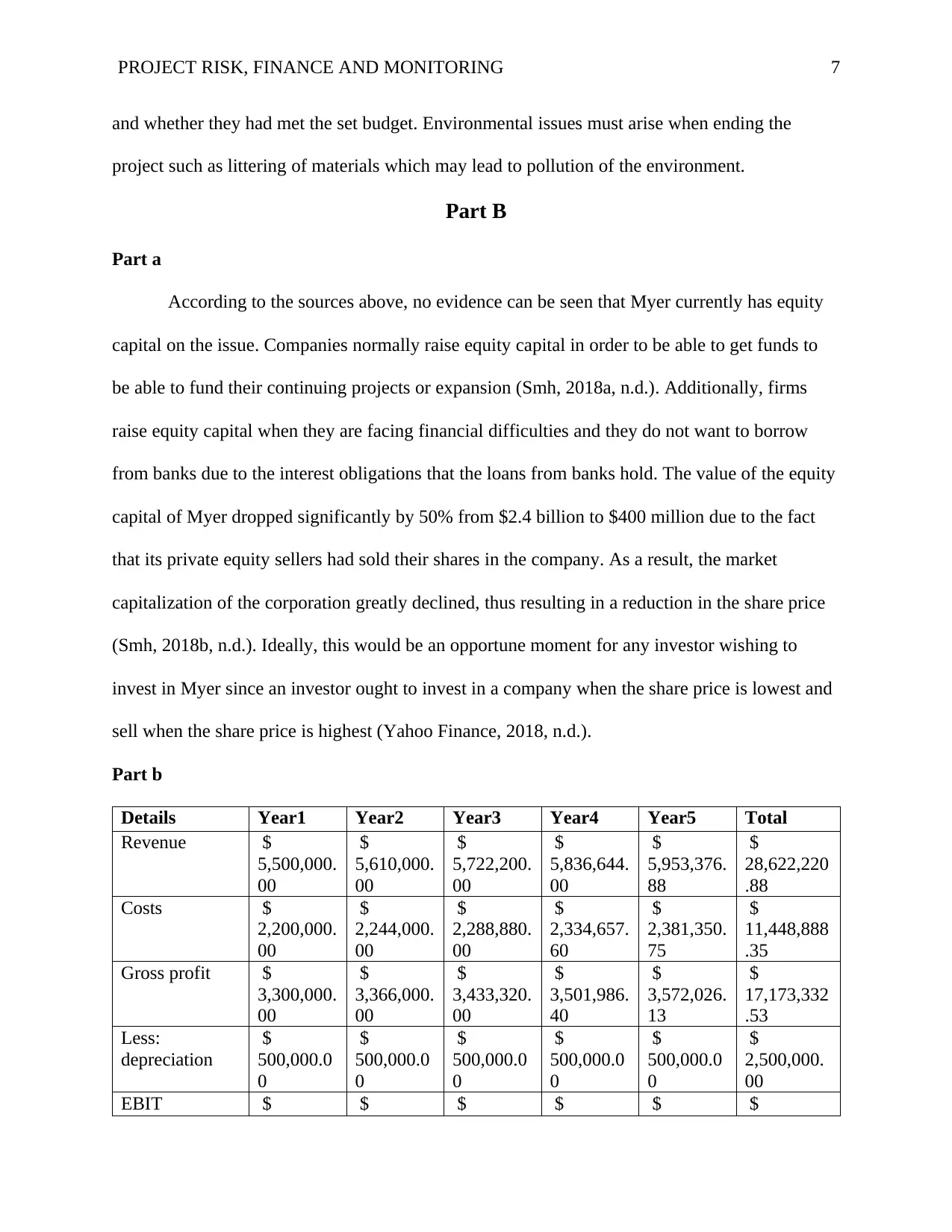
PROJECT RISK, FINANCE AND MONITORING 7
and whether they had met the set budget. Environmental issues must arise when ending the
project such as littering of materials which may lead to pollution of the environment.
Part B
Part a
According to the sources above, no evidence can be seen that Myer currently has equity
capital on the issue. Companies normally raise equity capital in order to be able to get funds to
be able to fund their continuing projects or expansion (Smh, 2018a, n.d.). Additionally, firms
raise equity capital when they are facing financial difficulties and they do not want to borrow
from banks due to the interest obligations that the loans from banks hold. The value of the equity
capital of Myer dropped significantly by 50% from $2.4 billion to $400 million due to the fact
that its private equity sellers had sold their shares in the company. As a result, the market
capitalization of the corporation greatly declined, thus resulting in a reduction in the share price
(Smh, 2018b, n.d.). Ideally, this would be an opportune moment for any investor wishing to
invest in Myer since an investor ought to invest in a company when the share price is lowest and
sell when the share price is highest (Yahoo Finance, 2018, n.d.).
Part b
Details Year1 Year2 Year3 Year4 Year5 Total
Revenue $
5,500,000.
00
$
5,610,000.
00
$
5,722,200.
00
$
5,836,644.
00
$
5,953,376.
88
$
28,622,220
.88
Costs $
2,200,000.
00
$
2,244,000.
00
$
2,288,880.
00
$
2,334,657.
60
$
2,381,350.
75
$
11,448,888
.35
Gross profit $
3,300,000.
00
$
3,366,000.
00
$
3,433,320.
00
$
3,501,986.
40
$
3,572,026.
13
$
17,173,332
.53
Less:
depreciation
$
500,000.0
0
$
500,000.0
0
$
500,000.0
0
$
500,000.0
0
$
500,000.0
0
$
2,500,000.
00
EBIT $ $ $ $ $ $
and whether they had met the set budget. Environmental issues must arise when ending the
project such as littering of materials which may lead to pollution of the environment.
Part B
Part a
According to the sources above, no evidence can be seen that Myer currently has equity
capital on the issue. Companies normally raise equity capital in order to be able to get funds to
be able to fund their continuing projects or expansion (Smh, 2018a, n.d.). Additionally, firms
raise equity capital when they are facing financial difficulties and they do not want to borrow
from banks due to the interest obligations that the loans from banks hold. The value of the equity
capital of Myer dropped significantly by 50% from $2.4 billion to $400 million due to the fact
that its private equity sellers had sold their shares in the company. As a result, the market
capitalization of the corporation greatly declined, thus resulting in a reduction in the share price
(Smh, 2018b, n.d.). Ideally, this would be an opportune moment for any investor wishing to
invest in Myer since an investor ought to invest in a company when the share price is lowest and
sell when the share price is highest (Yahoo Finance, 2018, n.d.).
Part b
Details Year1 Year2 Year3 Year4 Year5 Total
Revenue $
5,500,000.
00
$
5,610,000.
00
$
5,722,200.
00
$
5,836,644.
00
$
5,953,376.
88
$
28,622,220
.88
Costs $
2,200,000.
00
$
2,244,000.
00
$
2,288,880.
00
$
2,334,657.
60
$
2,381,350.
75
$
11,448,888
.35
Gross profit $
3,300,000.
00
$
3,366,000.
00
$
3,433,320.
00
$
3,501,986.
40
$
3,572,026.
13
$
17,173,332
.53
Less:
depreciation
$
500,000.0
0
$
500,000.0
0
$
500,000.0
0
$
500,000.0
0
$
500,000.0
0
$
2,500,000.
00
EBIT $ $ $ $ $ $
Paraphrase This Document
Need a fresh take? Get an instant paraphrase of this document with our AI Paraphraser
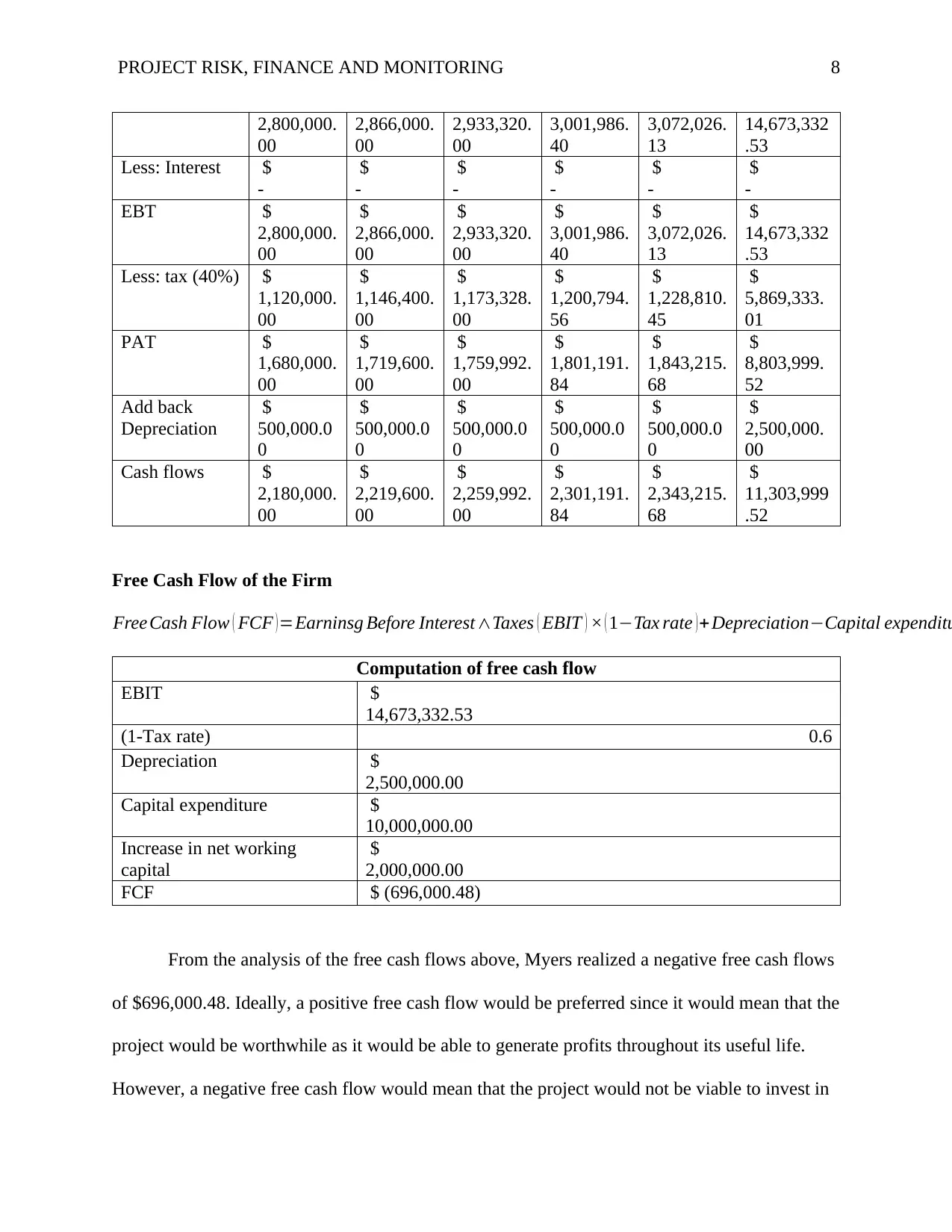
PROJECT RISK, FINANCE AND MONITORING 8
2,800,000.
00
2,866,000.
00
2,933,320.
00
3,001,986.
40
3,072,026.
13
14,673,332
.53
Less: Interest $
-
$
-
$
-
$
-
$
-
$
-
EBT $
2,800,000.
00
$
2,866,000.
00
$
2,933,320.
00
$
3,001,986.
40
$
3,072,026.
13
$
14,673,332
.53
Less: tax (40%) $
1,120,000.
00
$
1,146,400.
00
$
1,173,328.
00
$
1,200,794.
56
$
1,228,810.
45
$
5,869,333.
01
PAT $
1,680,000.
00
$
1,719,600.
00
$
1,759,992.
00
$
1,801,191.
84
$
1,843,215.
68
$
8,803,999.
52
Add back
Depreciation
$
500,000.0
0
$
500,000.0
0
$
500,000.0
0
$
500,000.0
0
$
500,000.0
0
$
2,500,000.
00
Cash flows $
2,180,000.
00
$
2,219,600.
00
$
2,259,992.
00
$
2,301,191.
84
$
2,343,215.
68
$
11,303,999
.52
Free Cash Flow of the Firm
FreeCash Flow ( FCF )=Earninsg Before Interest ∧Taxes ( EBIT ) × ( 1−Tax rate )+ Depreciation−Capital expenditu
Computation of free cash flow
EBIT $
14,673,332.53
(1-Tax rate) 0.6
Depreciation $
2,500,000.00
Capital expenditure $
10,000,000.00
Increase in net working
capital
$
2,000,000.00
FCF $ (696,000.48)
From the analysis of the free cash flows above, Myers realized a negative free cash flows
of $696,000.48. Ideally, a positive free cash flow would be preferred since it would mean that the
project would be worthwhile as it would be able to generate profits throughout its useful life.
However, a negative free cash flow would mean that the project would not be viable to invest in
2,800,000.
00
2,866,000.
00
2,933,320.
00
3,001,986.
40
3,072,026.
13
14,673,332
.53
Less: Interest $
-
$
-
$
-
$
-
$
-
$
-
EBT $
2,800,000.
00
$
2,866,000.
00
$
2,933,320.
00
$
3,001,986.
40
$
3,072,026.
13
$
14,673,332
.53
Less: tax (40%) $
1,120,000.
00
$
1,146,400.
00
$
1,173,328.
00
$
1,200,794.
56
$
1,228,810.
45
$
5,869,333.
01
PAT $
1,680,000.
00
$
1,719,600.
00
$
1,759,992.
00
$
1,801,191.
84
$
1,843,215.
68
$
8,803,999.
52
Add back
Depreciation
$
500,000.0
0
$
500,000.0
0
$
500,000.0
0
$
500,000.0
0
$
500,000.0
0
$
2,500,000.
00
Cash flows $
2,180,000.
00
$
2,219,600.
00
$
2,259,992.
00
$
2,301,191.
84
$
2,343,215.
68
$
11,303,999
.52
Free Cash Flow of the Firm
FreeCash Flow ( FCF )=Earninsg Before Interest ∧Taxes ( EBIT ) × ( 1−Tax rate )+ Depreciation−Capital expenditu
Computation of free cash flow
EBIT $
14,673,332.53
(1-Tax rate) 0.6
Depreciation $
2,500,000.00
Capital expenditure $
10,000,000.00
Increase in net working
capital
$
2,000,000.00
FCF $ (696,000.48)
From the analysis of the free cash flows above, Myers realized a negative free cash flows
of $696,000.48. Ideally, a positive free cash flow would be preferred since it would mean that the
project would be worthwhile as it would be able to generate profits throughout its useful life.
However, a negative free cash flow would mean that the project would not be viable to invest in
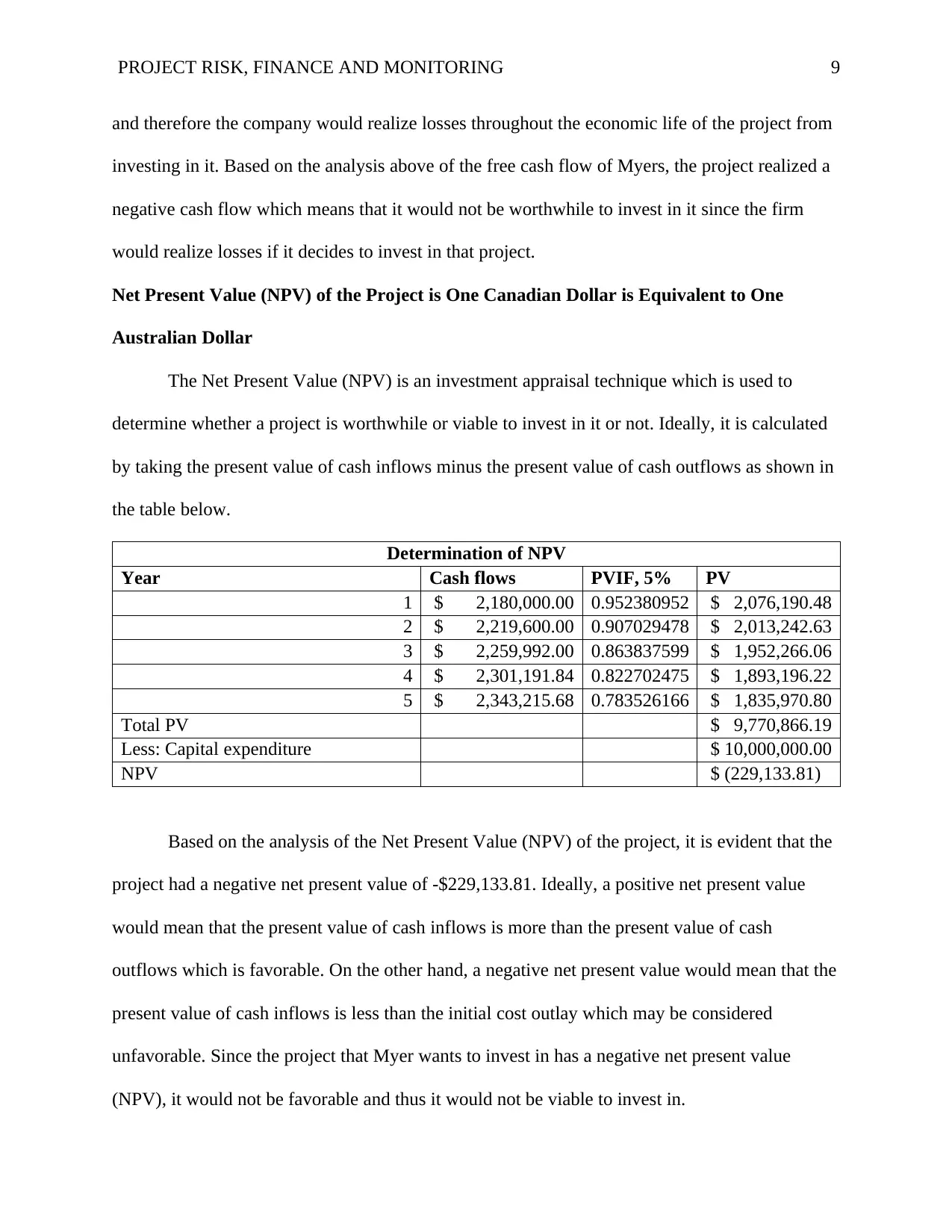
PROJECT RISK, FINANCE AND MONITORING 9
and therefore the company would realize losses throughout the economic life of the project from
investing in it. Based on the analysis above of the free cash flow of Myers, the project realized a
negative cash flow which means that it would not be worthwhile to invest in it since the firm
would realize losses if it decides to invest in that project.
Net Present Value (NPV) of the Project is One Canadian Dollar is Equivalent to One
Australian Dollar
The Net Present Value (NPV) is an investment appraisal technique which is used to
determine whether a project is worthwhile or viable to invest in it or not. Ideally, it is calculated
by taking the present value of cash inflows minus the present value of cash outflows as shown in
the table below.
Determination of NPV
Year Cash flows PVIF, 5% PV
1 $ 2,180,000.00 0.952380952 $ 2,076,190.48
2 $ 2,219,600.00 0.907029478 $ 2,013,242.63
3 $ 2,259,992.00 0.863837599 $ 1,952,266.06
4 $ 2,301,191.84 0.822702475 $ 1,893,196.22
5 $ 2,343,215.68 0.783526166 $ 1,835,970.80
Total PV $ 9,770,866.19
Less: Capital expenditure $ 10,000,000.00
NPV $ (229,133.81)
Based on the analysis of the Net Present Value (NPV) of the project, it is evident that the
project had a negative net present value of -$229,133.81. Ideally, a positive net present value
would mean that the present value of cash inflows is more than the present value of cash
outflows which is favorable. On the other hand, a negative net present value would mean that the
present value of cash inflows is less than the initial cost outlay which may be considered
unfavorable. Since the project that Myer wants to invest in has a negative net present value
(NPV), it would not be favorable and thus it would not be viable to invest in.
and therefore the company would realize losses throughout the economic life of the project from
investing in it. Based on the analysis above of the free cash flow of Myers, the project realized a
negative cash flow which means that it would not be worthwhile to invest in it since the firm
would realize losses if it decides to invest in that project.
Net Present Value (NPV) of the Project is One Canadian Dollar is Equivalent to One
Australian Dollar
The Net Present Value (NPV) is an investment appraisal technique which is used to
determine whether a project is worthwhile or viable to invest in it or not. Ideally, it is calculated
by taking the present value of cash inflows minus the present value of cash outflows as shown in
the table below.
Determination of NPV
Year Cash flows PVIF, 5% PV
1 $ 2,180,000.00 0.952380952 $ 2,076,190.48
2 $ 2,219,600.00 0.907029478 $ 2,013,242.63
3 $ 2,259,992.00 0.863837599 $ 1,952,266.06
4 $ 2,301,191.84 0.822702475 $ 1,893,196.22
5 $ 2,343,215.68 0.783526166 $ 1,835,970.80
Total PV $ 9,770,866.19
Less: Capital expenditure $ 10,000,000.00
NPV $ (229,133.81)
Based on the analysis of the Net Present Value (NPV) of the project, it is evident that the
project had a negative net present value of -$229,133.81. Ideally, a positive net present value
would mean that the present value of cash inflows is more than the present value of cash
outflows which is favorable. On the other hand, a negative net present value would mean that the
present value of cash inflows is less than the initial cost outlay which may be considered
unfavorable. Since the project that Myer wants to invest in has a negative net present value
(NPV), it would not be favorable and thus it would not be viable to invest in.
⊘ This is a preview!⊘
Do you want full access?
Subscribe today to unlock all pages.

Trusted by 1+ million students worldwide
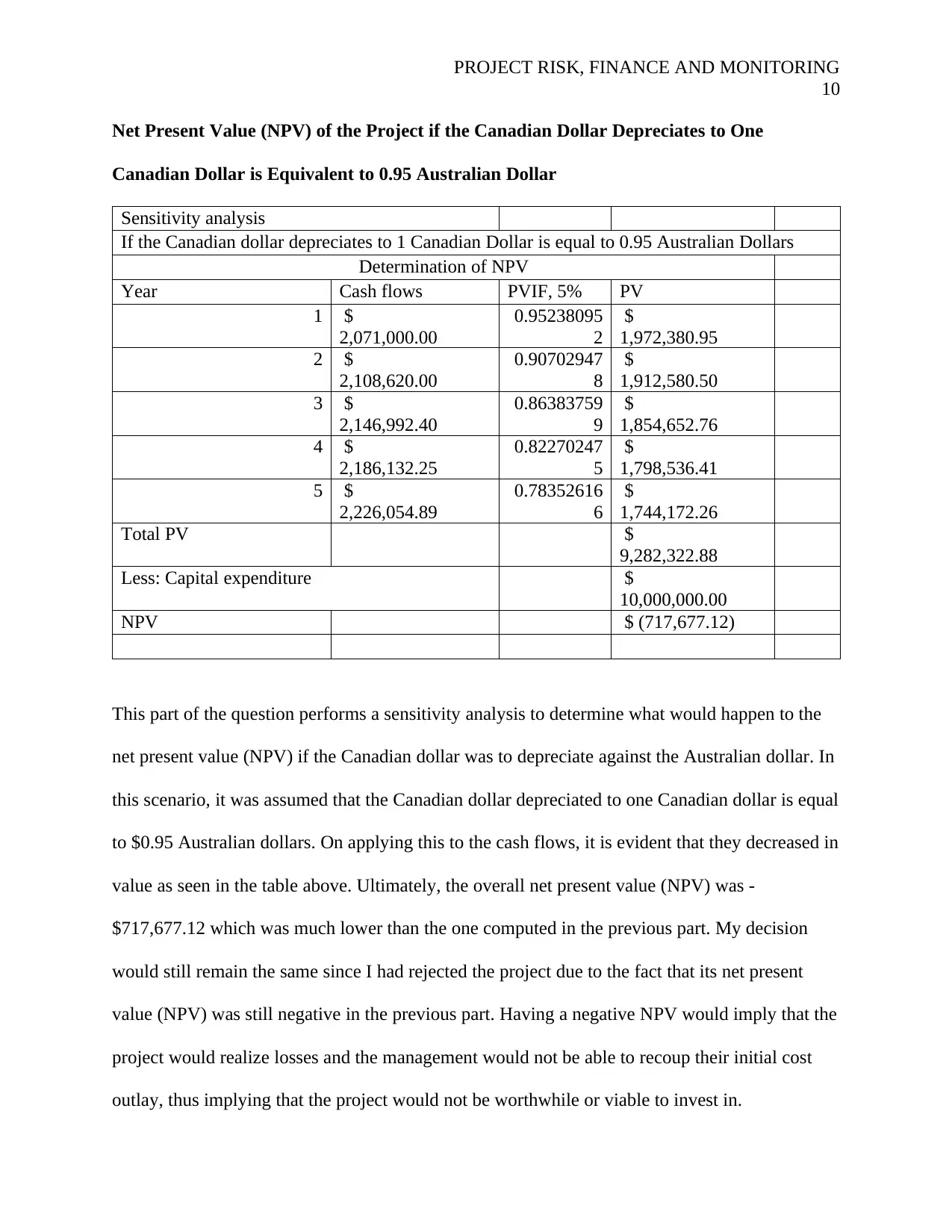
PROJECT RISK, FINANCE AND MONITORING
10
Net Present Value (NPV) of the Project if the Canadian Dollar Depreciates to One
Canadian Dollar is Equivalent to 0.95 Australian Dollar
Sensitivity analysis
If the Canadian dollar depreciates to 1 Canadian Dollar is equal to 0.95 Australian Dollars
Determination of NPV
Year Cash flows PVIF, 5% PV
1 $
2,071,000.00
0.95238095
2
$
1,972,380.95
2 $
2,108,620.00
0.90702947
8
$
1,912,580.50
3 $
2,146,992.40
0.86383759
9
$
1,854,652.76
4 $
2,186,132.25
0.82270247
5
$
1,798,536.41
5 $
2,226,054.89
0.78352616
6
$
1,744,172.26
Total PV $
9,282,322.88
Less: Capital expenditure $
10,000,000.00
NPV $ (717,677.12)
This part of the question performs a sensitivity analysis to determine what would happen to the
net present value (NPV) if the Canadian dollar was to depreciate against the Australian dollar. In
this scenario, it was assumed that the Canadian dollar depreciated to one Canadian dollar is equal
to $0.95 Australian dollars. On applying this to the cash flows, it is evident that they decreased in
value as seen in the table above. Ultimately, the overall net present value (NPV) was -
$717,677.12 which was much lower than the one computed in the previous part. My decision
would still remain the same since I had rejected the project due to the fact that its net present
value (NPV) was still negative in the previous part. Having a negative NPV would imply that the
project would realize losses and the management would not be able to recoup their initial cost
outlay, thus implying that the project would not be worthwhile or viable to invest in.
10
Net Present Value (NPV) of the Project if the Canadian Dollar Depreciates to One
Canadian Dollar is Equivalent to 0.95 Australian Dollar
Sensitivity analysis
If the Canadian dollar depreciates to 1 Canadian Dollar is equal to 0.95 Australian Dollars
Determination of NPV
Year Cash flows PVIF, 5% PV
1 $
2,071,000.00
0.95238095
2
$
1,972,380.95
2 $
2,108,620.00
0.90702947
8
$
1,912,580.50
3 $
2,146,992.40
0.86383759
9
$
1,854,652.76
4 $
2,186,132.25
0.82270247
5
$
1,798,536.41
5 $
2,226,054.89
0.78352616
6
$
1,744,172.26
Total PV $
9,282,322.88
Less: Capital expenditure $
10,000,000.00
NPV $ (717,677.12)
This part of the question performs a sensitivity analysis to determine what would happen to the
net present value (NPV) if the Canadian dollar was to depreciate against the Australian dollar. In
this scenario, it was assumed that the Canadian dollar depreciated to one Canadian dollar is equal
to $0.95 Australian dollars. On applying this to the cash flows, it is evident that they decreased in
value as seen in the table above. Ultimately, the overall net present value (NPV) was -
$717,677.12 which was much lower than the one computed in the previous part. My decision
would still remain the same since I had rejected the project due to the fact that its net present
value (NPV) was still negative in the previous part. Having a negative NPV would imply that the
project would realize losses and the management would not be able to recoup their initial cost
outlay, thus implying that the project would not be worthwhile or viable to invest in.
Paraphrase This Document
Need a fresh take? Get an instant paraphrase of this document with our AI Paraphraser
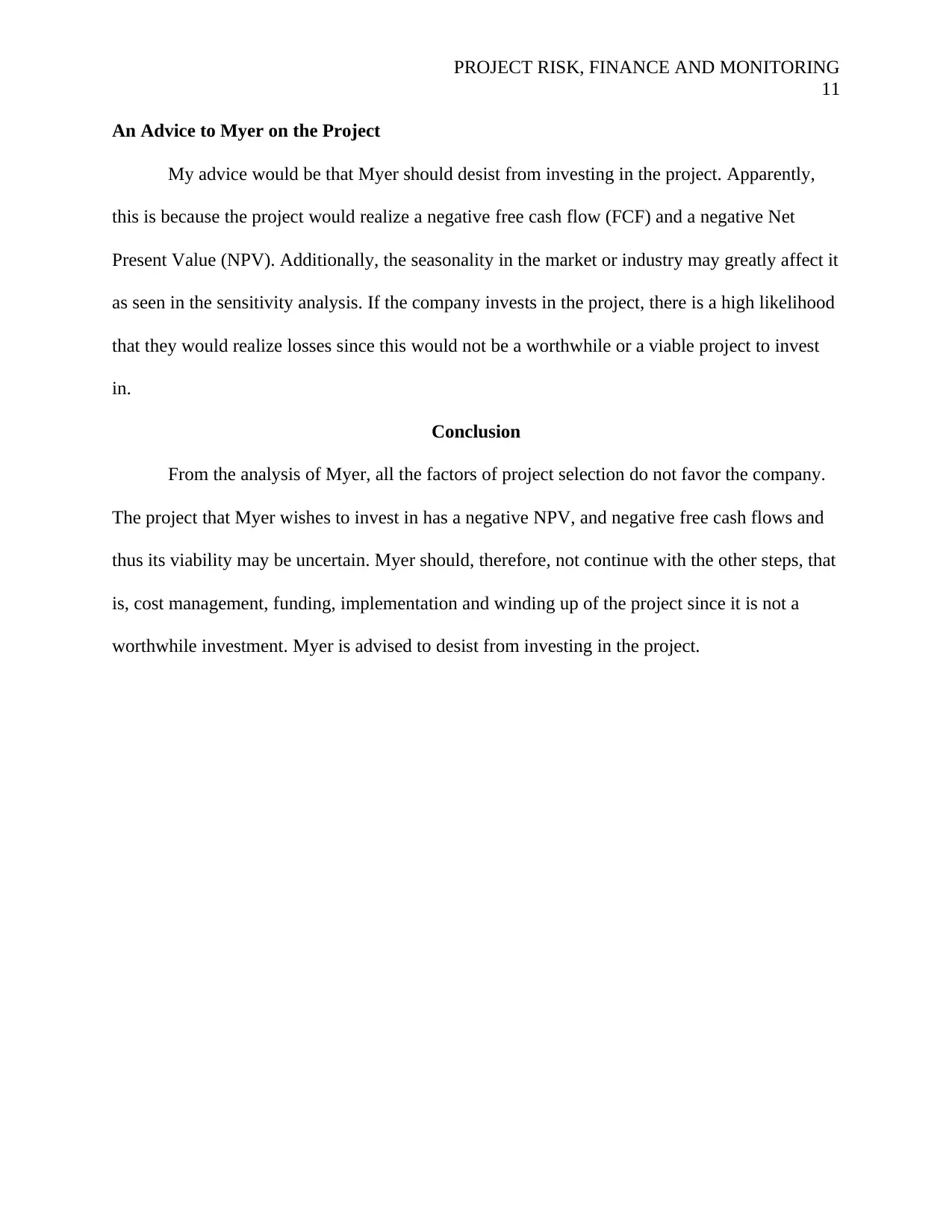
PROJECT RISK, FINANCE AND MONITORING
11
An Advice to Myer on the Project
My advice would be that Myer should desist from investing in the project. Apparently,
this is because the project would realize a negative free cash flow (FCF) and a negative Net
Present Value (NPV). Additionally, the seasonality in the market or industry may greatly affect it
as seen in the sensitivity analysis. If the company invests in the project, there is a high likelihood
that they would realize losses since this would not be a worthwhile or a viable project to invest
in.
Conclusion
From the analysis of Myer, all the factors of project selection do not favor the company.
The project that Myer wishes to invest in has a negative NPV, and negative free cash flows and
thus its viability may be uncertain. Myer should, therefore, not continue with the other steps, that
is, cost management, funding, implementation and winding up of the project since it is not a
worthwhile investment. Myer is advised to desist from investing in the project.
11
An Advice to Myer on the Project
My advice would be that Myer should desist from investing in the project. Apparently,
this is because the project would realize a negative free cash flow (FCF) and a negative Net
Present Value (NPV). Additionally, the seasonality in the market or industry may greatly affect it
as seen in the sensitivity analysis. If the company invests in the project, there is a high likelihood
that they would realize losses since this would not be a worthwhile or a viable project to invest
in.
Conclusion
From the analysis of Myer, all the factors of project selection do not favor the company.
The project that Myer wishes to invest in has a negative NPV, and negative free cash flows and
thus its viability may be uncertain. Myer should, therefore, not continue with the other steps, that
is, cost management, funding, implementation and winding up of the project since it is not a
worthwhile investment. Myer is advised to desist from investing in the project.

PROJECT RISK, FINANCE AND MONITORING
12
References
Adrian, T., Covitz, D. and Liang, N., 2015. Financial stability monitoring. Annual Review of
Financial Economics, 7, pp.357-395. [Accessed on 30th May 2018].
Delmon, J., 2009. Private sector investment in infrastructure: Project finance, PPP projects, and
risks. Kluwer Law International. [Accessed on 30th May 2018].
Demirag, I., 2017. A framework for examining accountability and value for money in the UK’s
private finance initiative. In Corporate Social Responsibility, Accountability and
Governance (pp. 77-92). Routledge. [Accessed on 30th May 2018].
Diamond, D.W., 1984. Financial intermediation and delegated monitoring. The review of
economic studies, 51(3), pp.393-414. [Accessed on 30th May 2018].
Kerzner, H., 2017. Project management metrics, KPIs, and dashboards: a guide to measuring
and monitoring project performance. John Wiley & Sons. [Accessed on 30th May 2018].
Kleimeier, S. and Megginson, W.L., 2000. Are project finance loans different from other
syndicated credits? Journal of Applied Corporate Finance, 13(1), pp.75-87. [Accessed on
30th May 2018].
Lee, E., Park, Y. and Shin, J.G., 2009. Large engineering project risk management using a
Bayesian belief network. Expert Systems with Applications, 36(3), pp.5880-5887.
[Accessed on 30th May 2018].
Olson, D.L. and Wu, D.D., 2017. Data Mining Models and Enterprise Risk Management. In
Enterprise Risk Management Models (pp. 119-132). Springer, Berlin, Heidelberg.
[Accessed on 30th May 2018].
12
References
Adrian, T., Covitz, D. and Liang, N., 2015. Financial stability monitoring. Annual Review of
Financial Economics, 7, pp.357-395. [Accessed on 30th May 2018].
Delmon, J., 2009. Private sector investment in infrastructure: Project finance, PPP projects, and
risks. Kluwer Law International. [Accessed on 30th May 2018].
Demirag, I., 2017. A framework for examining accountability and value for money in the UK’s
private finance initiative. In Corporate Social Responsibility, Accountability and
Governance (pp. 77-92). Routledge. [Accessed on 30th May 2018].
Diamond, D.W., 1984. Financial intermediation and delegated monitoring. The review of
economic studies, 51(3), pp.393-414. [Accessed on 30th May 2018].
Kerzner, H., 2017. Project management metrics, KPIs, and dashboards: a guide to measuring
and monitoring project performance. John Wiley & Sons. [Accessed on 30th May 2018].
Kleimeier, S. and Megginson, W.L., 2000. Are project finance loans different from other
syndicated credits? Journal of Applied Corporate Finance, 13(1), pp.75-87. [Accessed on
30th May 2018].
Lee, E., Park, Y. and Shin, J.G., 2009. Large engineering project risk management using a
Bayesian belief network. Expert Systems with Applications, 36(3), pp.5880-5887.
[Accessed on 30th May 2018].
Olson, D.L. and Wu, D.D., 2017. Data Mining Models and Enterprise Risk Management. In
Enterprise Risk Management Models (pp. 119-132). Springer, Berlin, Heidelberg.
[Accessed on 30th May 2018].
⊘ This is a preview!⊘
Do you want full access?
Subscribe today to unlock all pages.

Trusted by 1+ million students worldwide
1 out of 13
Related Documents
Your All-in-One AI-Powered Toolkit for Academic Success.
+13062052269
info@desklib.com
Available 24*7 on WhatsApp / Email
![[object Object]](/_next/static/media/star-bottom.7253800d.svg)
Unlock your academic potential
Copyright © 2020–2025 A2Z Services. All Rights Reserved. Developed and managed by ZUCOL.





